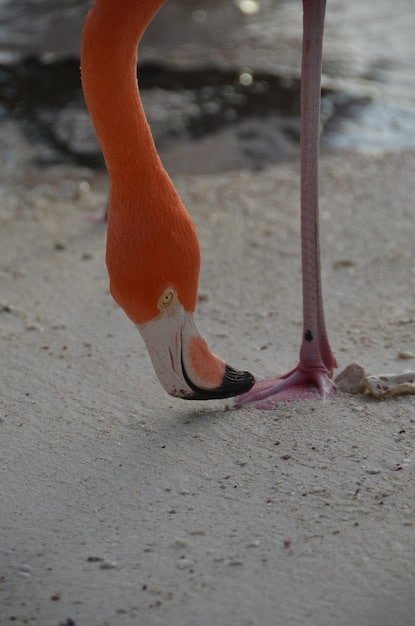The Great Flamingo Escape: Unraveling Miami Zoo’s Mystery

The Great Flamingo Escape at Miami Zoo remains an intriguing incident, marked by the unexpected departure of numerous flamingos, prompting questions about the circumstances and potential factors behind this avian exodus.
Have you ever wondered about the mysteries that lie within the walls of our zoos? What happens when the animals decide they’ve had enough? Prepare to delve into one of the most bizarre and perplexing events in recent zoo history: The Great Flamingo Escape at Miami Zoo, an unexplained avian exodus that left zookeepers and animal enthusiasts scratching their heads.
The Initial Discovery: A Flamingo-Free Zone
Imagine arriving at your workplace one morning, only to find that a significant portion of your colleagues has vanished without a trace. That’s precisely what happened at Miami Zoo when zookeepers discovered a startlingly low number of flamingos in their enclosure. The initial shock quickly turned into a frantic search and a pressing need to understand what could have possibly caused such an event.
But what could have led to such an event? The burning question on everyone’s mind was, “How did so many flamingos manage to leave their habitat at once?” This incident was unprecedented and raised significant concerns about the zoo’s security measures and the well-being of the remaining animals.
The Immediate Response from Zoo Authorities
In the wake of the discovery, Miami Zoo authorities launched an immediate investigation to ascertain the facts and prevent any recurrence. Their primary focus was on understanding the circumstances that allowed the flamingos to escape and ensuring the safety and security of the remaining wildlife. The zoo’s spokesperson, Maria Sanchez, stated, “We are taking this incident very seriously. Our priority is to understand what happened and reinforce our protocols to ensure such an event does not happen again.”
Here are some of the initial steps taken:
- Security Assessment: A thorough review of the zoo’s perimeter and internal security systems.
- Animal Count: A precise count of the remaining flamingos and other birds to identify any additional missing animals.
- Staff Interviews: Conversations with zookeepers and other staff members to gather any relevant information about changes in animal behavior or potential security breaches.

The zoo authorities were determined to resolve the mystery swiftly and transparently, reassuring the public that the welfare of their animals was their utmost concern. The incident prompted a wave of questions, as people sought reassurance about the safety and care of the zoo’s inhabitants.
Possible Causes: Unraveling the Mystery
As investigations deepened, various theories emerged, each attempting to explain the unexplained avian exodus. Experts considered factors ranging from natural triggers to human interference. A detailed examination of the potential causes helps in understanding the complexity of the event and the challenges in zoo management.
To get to the bottom of The Great Flamingo Escape, investigators looked into several possible causes. Could it have been a matter of the environment, or something more sinister at play?
Environmental Factors: A Natural Trigger?
One leading theory focused on environmental factors. Changes in weather patterns, water levels, or even seismic activity could have disrupted the flamingos’ natural behavior. Flamingos are highly sensitive to their environment, and any drastic shift could have prompted them to seek a more suitable habitat.
Some specific factors considered included:
- Sudden Weather Changes: Severe storms or unexpected cold fronts could have startled the birds, compelling them to flee.
- Water Level Fluctuations: Changes in water levels in their enclosure might have made it less habitable or accessible.
- Habitat Degradation: Degradation of their enclosure due to pollution or other factors could have made the flamingos uncomfortable.
Human Interference: A Deliberate Act?
Another angle of investigation explored the possibility of human interference. Sabotage or a deliberate act of releasing the flamingos could not be ruled out. This theory gained traction as authorities examined the zoo’s security protocols and potential vulnerabilities.
The investigation considered:
- Security Breaches: Any evidence of unauthorized entry into the flamingo enclosure.
- Insider Involvement: The possibility of a disgruntled employee or someone with malicious intent.
- External Threats: Any signs of external groups or individuals targeting the zoo.
The Role of Animal Behavior and Psychology
Animal behaviorists also weighed in, suggesting that changes in the flamingos’ social dynamics or psychological well-being could have played a significant role. Overcrowding, stress, or changes in the flock’s leadership could have led to a collective decision to leave.
Key considerations included:
- Social Dynamics: Disruptions in the flock’s social hierarchy or increased competition for resources.
- Stress Levels: Elevated stress levels due to external factors like noise pollution or visitor disturbances.
- Flock Mentality: The influence of a few dominant individuals leading the rest of the flock to escape.
Ultimately, determining the exact cause of The Great Flamingo Escape required a comprehensive analysis of all these factors, combining insights from various fields of expertise to uncover the truth behind this bizarre event.
The Search and Rescue Operation
Once the flamingos were confirmed missing, a large-scale search and rescue operation was launched. The effort involved zoo staff, local law enforcement, and even community volunteers. The goal was to locate and safely return the escaped flamingos to their habitat.
The task force coordinated efforts across various fronts, using techniques and manpower to cover ground efficiently.
Coordinating Efforts: A Multi-Agency Approach
The search operation was a coordinated effort involving multiple agencies and organizations. Miami Zoo staff worked closely with local law enforcement, wildlife experts, and community volunteers. This collaboration was essential for covering a wide area and utilizing various resources effectively.
Key elements of the coordinated approach included:
- Establishing a Command Center: A central location for coordinating search efforts and disseminating information.
- Dividing Search Areas: Assigning specific areas to different teams to ensure thorough coverage.
- Utilizing Technology: Employing drones, GPS tracking, and thermal imaging to locate the flamingos.
Challenges Faced During the Search
The search and rescue operation faced several challenges. Flamingos are mobile and can travel long distances, making it difficult to predict their whereabouts. The terrain around Miami, including wetlands and urban areas, added to the complexity of the search.
Challenges included:
- Vast Search Area: The need to cover a wide geographical area, including both urban and natural environments.
- Difficult Terrain: Navigating wetlands, swamps, and densely populated areas.
- Weather Conditions: Coping with unpredictable weather patterns, including heat, humidity, and storms.
Community Involvement: The Role of Volunteers
Community volunteers played a significant role in the search and rescue operation. Local residents, animal enthusiasts, and environmental groups joined forces to assist in the search efforts. Their knowledge of the local area and their dedication proved invaluable.
How volunteers were involved:
- Spotting Teams: Volunteers patrolled assigned areas, looking for signs of the escaped flamingos.
- Information Dissemination: Spreading awareness through social media, local news outlets, and community networks.
- Providing Support: Offering logistical support, such as providing food, water, and transportation to search teams.
Thanks to the community and the authorities, a major crisis was averted. The event underscored the importance of preparedness and strong community bonds.
The Aftermath: Lessons Learned and Improved Protocols
Following the successful recovery of the escaped flamingos, Miami Zoo undertook a comprehensive review of its security protocols and animal management practices. The goal was to identify vulnerabilities and implement measures to prevent similar incidents in the future.
The zoo acknowledged that events such as The Great Flamingo Escape underscore how the animal care ecosystem is constantly evolving. As a result, it decided to take action.
Reviewing Security Protocols
The first step was a thorough review of the zoo’s security protocols. This involved assessing the perimeter fencing, surveillance systems, and access controls. Any weaknesses identified were addressed promptly to strengthen the zoo’s defenses against future breaches.
Key improvements included:
- Enhanced Fencing: Reinforcing perimeter fencing with additional layers of protection and monitoring.
- Advanced Surveillance: Installing state-of-the-art surveillance cameras with night vision and motion detection capabilities.
- Improved Access Controls: Implementing stricter access controls for staff and visitors, including biometric identification systems.
Enhancing Animal Enclosures
In addition to security improvements, the zoo focused on enhancing the animal enclosures. This involved making the habitats more secure, comfortable, and stimulating for the animals. The goal was to minimize stress and reduce the likelihood of escape attempts.
Specific enhancements included:
- Habitat Enrichment: Providing toys, climbing structures, and other enrichment items to keep animals mentally and physically engaged.
- Natural Barriers: Incorporating natural barriers, such as moats, rock formations, and dense vegetation, to deter escapes.
- Climate Control: Improving climate control systems to maintain optimal temperature and humidity levels in the enclosures.

Training and Education
Training and education programs were ramped up for zoo staff to ensure they were well-prepared to handle any situation. The programs covered animal behavior, emergency response protocols, and security awareness. Regular drills and simulations were conducted to reinforce the training.
Zoo’s investment in training and education:
- Animal Behavior Workshops: Training sessions on understanding animal behavior patterns and recognizing signs of distress or unrest.
- Emergency Response Drills: Regular drills simulating various emergency scenarios, such as animal escapes, natural disasters, and security breaches.
- Security Awareness Training: Educating staff on security protocols, access controls, and reporting procedures.
The Great Flamingo Escape served as a catalyst for positive change at Miami Zoo. By learning from the incident and implementing comprehensive improvements, the zoo has strengthened its ability to protect its animals and provide a safe and enriching environment for both wildlife and visitors.
Public Perception and Media Coverage
The Great Flamingo Escape garnered significant media attention, both locally and nationally. News outlets, social media platforms, and online forums buzzed with discussions about the incident. Public perception varied, with some expressing concern for the animals’ welfare and others viewing the event with a sense of humor.
The media landscape around the event ranged from outrage to curiosity. These are the key elements:
The Initial Media Frenzy
As news of the flamingo escape broke, media outlets rushed to cover the story. Television news, online publications, and social media platforms were flooded with reports, images, and videos related to the incident. The story quickly went viral, capturing the attention of audiences worldwide.
How media covered the story:
- Breaking News: Immediate reports announcing the escape and the launch of the search operation.
- On-Scene Coverage: Live broadcasts from Miami Zoo, featuring interviews with zoo staff, law enforcement, and community members.
- Social Media Buzz: Trending hashtags, memes, and discussions about the flamingo escape on platforms like Twitter, Facebook, and Instagram.
Public Reaction: Concern vs. Amusement
Public reaction to The Great Flamingo Escape was mixed. Many people expressed genuine concern for the welfare of the escaped flamingos. Others viewed the incident with a sense of amusement, creating memes and jokes about the avian adventure. This duality in public perception highlighted the complex relationship between humans and wildlife.
The range of public reactions:
- Concern for Animal Welfare: Expressing empathy and worry about the safety and well-being of the escaped flamingos.
- Humorous Reactions: Creating memes, jokes, and humorous content related to the incident.
- Critique of Zoo Management: Questioning the zoo’s security protocols and animal management practices.
Managing the Narrative: Zoo’s PR Response
Miami Zoo’s public relations team played a crucial role in managing the narrative surrounding The Great Flamingo Escape. They worked to provide accurate information, address public concerns, and reassure the community that the situation was under control. Transparency and effective communication were key to maintaining public trust.
The zoo’s PR response strategy:
- Transparency and Open Communication: Providing regular updates to the media and the public about the progress of the search operation.
- Highlighting Animal Welfare: Emphasizing the zoo’s commitment to animal welfare and the steps taken to ensure the safety of the escaped flamingos.
- Community Engagement: Encouraging community involvement in the search efforts and thanking volunteers for their support.
The Greater Impact on Zoo Security Worldwide
The Great Flamingo Escape at Miami Zoo became a learning experience for zoos worldwide. The incident prompted a global re-evaluation of security measures and animal management practices. Zoos began sharing best practices and collaborating to improve their overall security posture.
Many zoos implemented changes as a result of the escape. The incident opened a lot of eyes and many learned best practices.
Sharing Best Practices: A Global Collaboration
Following The Great Flamingo Escape, there was a significant increase in collaboration among zoos worldwide. This collaboration involved sharing best practices, lessons learned, and innovative security solutions.
How zoos collaborated:
- Conferences and Workshops: Organizing international conferences and workshops to discuss security protocols and animal management techniques.
- Online Forums: Creating online forums and networks for zoo professionals to exchange information and insights.
- Site Visits: Conducting site visits to observe and learn from other zoos’ security systems and animal enclosures.
Investing in Technology: Cutting-Edge Security Solutions
Many zoos started investing in advanced technology to enhance their security systems. This included the use of drones, thermal imaging, and artificial intelligence to monitor animal enclosures and detect potential breaches.
Examples of technology investment:
- Drone Surveillance: Employing drones equipped with cameras and sensors to patrol zoo perimeters and animal habitats.
- Thermal Imaging: Using thermal imaging technology to detect unusual activity or changes in animal behavior.
- Artificial Intelligence: Implementing AI-powered systems to analyze data from surveillance cameras and sensors.
Re-evaluating Animal Enclosures: Balancing Security and Welfare
Zoos also focused on re-evaluating their animal enclosures to strike a better balance between security and animal welfare. The goal was to create habitats that were both safe and stimulating for the animals.
Key considerations in re-evaluating enclosures:
- Enrichment Programs: Enhancing animal enrichment programs to provide mental and physical stimulation.
- Natural Habitats: Designing enclosures that mimic natural habitats as closely as possible.
- Stress Reduction: Implementing measures to reduce stress levels among animals, such as noise barriers and visitor management strategies.
Ultimately, The Great Flamingo Escape prompted a global movement toward improved zoo security and animal welfare. By sharing best practices, harnessing technology, and re-evaluating animal enclosures, zoos worldwide are better equipped to prevent future incidents and maintain the well-being of their animals.
| Key Point | Brief Description |
|---|---|
| 🚨Avian Exodus | Flamingos mysteriously escaped, causing zoo concerns. |
| 🔍Investigation | Zoo examined causes: environmental, human, or animal behavior. |
| 🤝Community Help | Volunteers aided search, showcasing community support. |
| 🔒Security Boost | Enhanced protocols, tech, and animal enrichment followed escape. |
Frequently Asked Questions
▼
The escape was likely due to a combination of factors, including environmental triggers, potential human interference, security vulnerabilities and changes in animal behavior.
▼
While the exact number may vary in reports, a significant portion of the flamingo population was missing, which prompted the search and rescue operation.
▼
Yes. The event exposed vulnerabilities in established security protocols. It prompted a complete review and upgrade of security and enclosure.
▼
Enhancements were made including reinforcing perimeter fencing, enhancing surveillance systems, and improving access controls for staff and visitors.
▼
The community played a significant role in various tasks, including spotting teams, disseminating of rescue information, and providing logistical support to personnel.
Conclusion
The Great Flamingo Escape at Miami Zoo was a bizarre and perplexing event that raised important questions about zoo security, animal welfare, and the delicate balance between humans and wildlife. By learning from this incident and implementing comprehensive improvements, zoos worldwide can better protect their animals and provide enriching experiences for both wildlife and visitors.





